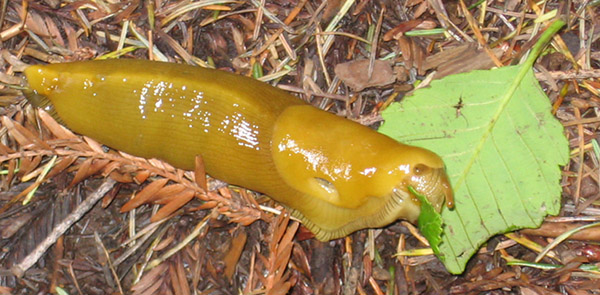
|
Macro
on the move by Erin Thomas, USA |
Editor's note: The author Erin Thomas has recently returned from an extended car journey across the western United States and photographed the smaller fauna and flora he came across. He kindly shares a selection of his photos taken and observations during his journey below which were emailed to Micscape as he reached Internet access points. With additional notes by his entomologist friend Ernest Anderson who answered his emailed identification queries while travelling. Notes in square brackets as well as comments where noted in the text are identifications kindly offered by David Richman on the author's return.
Author's
introduction:
These are the first
photographs I have ever taken of insects, and it was pure spontaneity. I have a friend who is an entomologist
whom I have been on several hikes with over the past few years. His
drawing my attention to insects and their behaviors during our hikes has caused me to take
more and more notice
of them in everyday life. I will now even spot them
crawling across a highway when I am driving 65 miles an hour with time enough to
casually move over a bit so I don't crush them under my tires.
It's a neat paradigm shift to go from seeing a sort of barren lifeless "human" world to seeing life pretty much everywhere.
I experimented
quite a bit with bug photography during my road trip, and I plan to continue
with this experimentation in the future. There is an element of natural
humor that crops up around most attempts to snap pictures of very mobile insects,
some of which have stingers, on stems and boughs that are waving wildly about in
the wind. I've discovered that there are realizations after the fact, too. For
instance, the pale bee I got a picture of (below): I thought it was just sitting there
on the stem taking a break when I took the picture. I only saw that it was being
eaten by a spider after I got the pictures loaded up onto my laptop and looked
at them in there. I was really surprised by this. In fact, astonished. I
couldn't believe that I just didn't realize this bee was paralyzed and being fed
upon during the twenty or so minutes I spent trying to get a few decent pictures
of it.
Banana slug from Usal Beach, California:
The first photograph I snapped of an insect on my
trip is of this banana slug. I took notice of it while walking through a
grove I have a
special interest in. I've actually taken the time to watch a banana slug eat before. Quite an
interesting thing. This slug is actually in the active process of eating that
alder leaf. It's got the leaf griped in its mouth parts, bent sideways.

These photos were
all taken off of Highway 188 in Arizona, about 5 miles north of Punkin
Center:
These photos represent the first attempt I ever made to look for
and photograph insects. I had no idea how the
camera worked with regard to photographing small objects up close. It is a
Canon PowerShot A510. I had originally pulled off the highway to get a
few pictures of the area for my girlfriend because it was lovely country. But as I walked around looking for good vantage points, I
noticed these beetles feeding on this plant and decided to see if I
could get a decent picture of them.
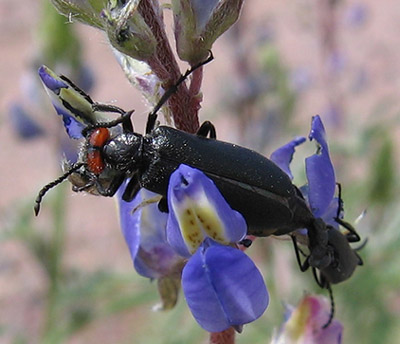
A friend of mine, Ernest Anderson, has informed me that these beetles are not only eating, they're also mating. David Richman kindly tells me that they are in the Meloidae family.
After taking some photos of the above insect and seeing how they looked very vivid on the digital camera's preview display, I became excited and started looking more closely at the bushes. As I did so, I took notice of the following spider eating another insect.
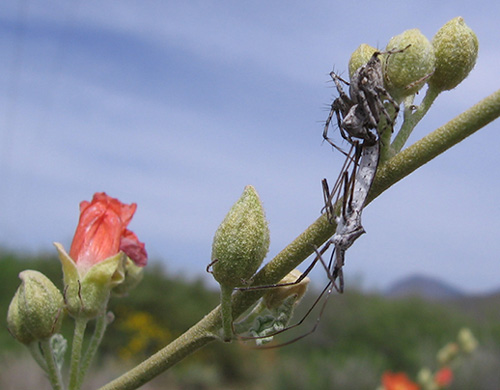
David Richman has kindly identified the spider as a lynx spider (family Oxyopidae) eating an assassin bug (family Reduviidae).
The beetle below was extremely difficult to get a picture of. It was aware of me and
worked very hard to stay out of line-of-sight from me. It was only after moving
around the flower back into line-of-sight several times that the beetle
apparently gave up and allowed me this view. I took other photos of this beetle,
but this photo is the only one that turned out well enough to share. Ernest felt
that this looks like a beetle in the family
Carabidae. David Richman kindly adds that: 'Carabids (except perhaps Lebia and relatives) are not usually found in
flowers. I therefore doubt that this is a carabid. As there are several
families found in such situations (mostly pollen or nectar feeders) I cannot say
for sure.'
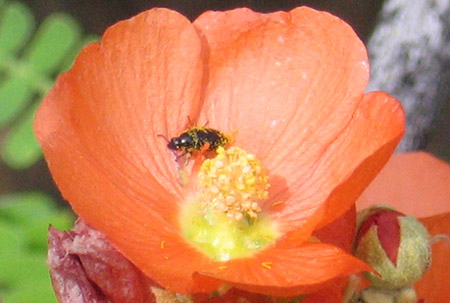
I spent a good deal of time trying to get a picture of the bee
below. It was very
busy. Although it noticed me and didn't want to spend much time near me, it was
also very interested in its pollen collection and overcame its fear of me enough
to come back to the plant and continue its work. This made it possible for me to
snap a couple of photos. This is a different plant altogether from the one above
that the beetle is on. I don't know what kind of plant this flower is blooming
on, but I saw similar flowering plants in much of the southwest as I traveled.
Ernest wrote back telling me that this is a bee,
but that there are more than 20,000 different bee species, making this busy
little creature potentially very difficult to identify. He went on to point out
that most such bees are
solitary, not living in colonies like honey bees do.

The bee below is a different
individual than one
above, though I suppose it may be of the same species.
To get this picture I spent a good deal of time moving the plant around. This
bee seemed so frightened of me that it wouldn't even leave the cup of this
flower to get away, favoring instead the idea of hiding behind the stamens out of direct
line-of-sight. After I took hold of the flower's stalk, and began to carefully
move the flower around in order to move the cup such that I could get the bee
back into direct line-of-sight, the bee eventually seemed to give up, backing
into the position you see here:
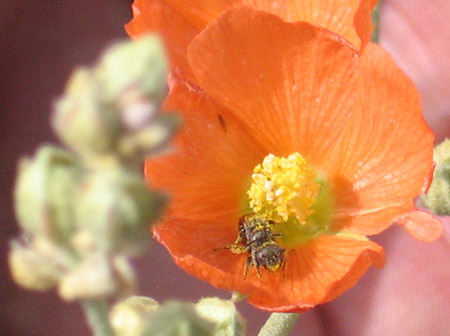
This creature below was very active, moving all over the flower. This is a different plant still from the ones above. This bug, like some of the others, regularly moved to the other side of the stem and flowers in order to get out of direct line-of-sight from me. But, I was starting to gain some proficiency with the camera by this time. I figured out by this point that it had a feature which allows you to tell it how far away an object of interest is, making it possible to hold the camera that particular distance away. So, despite this bug's movement, I managed to get two photos out of the six or so that I took that turned out well enough to share.
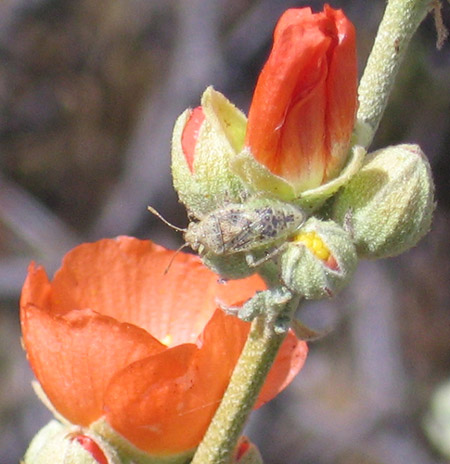
Ernest told me that this is not a beetle (I thought it was). It is a true bug nymph, a rhopalid (Family Rhopalidae). Its colors camouflage it pretty well on this plant.
As I mentioned above, I didn't realize
this bee was being eaten by a spider when I took the picture below.
In fact, I thought it was just hanging out on the plant resting. It was
only when I saw the photos that I realized there was something holding onto it,
feeding off of it. I also didn't notice the ant that was getting in on the
action at the time I took the picture. I learned from Ernest that this is
possibly one of the 20,000 species of solitary bees, and
that the spider eating it is another crab spider that has evolved to look like a
part of the flower, thus making it invisible to the bee, and apparently to me as
well.

I just noticed this chrysalis below as I was walking back to my car. There's no way really to know what sort of insect is pupating inside of it.
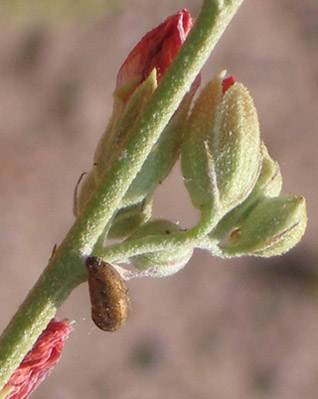
Someone told me that this blossom below may be a dandelion flower. If so, this is easily the largest dandelion flower I have ever seen. I think it was over four inches across. Pretty impressive. Somehow I don't think I would feel comfortable making a wish on this giant. I would be lucky if I blew just one of the seeds off, never mind all of them. [On reflection, it is not a dandelion. An Alium has been kindly suggested].
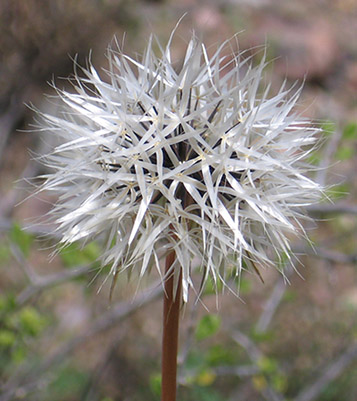
Two bugs off Highway 191 in Arizona, 25
miles south of Clifton, Arizona:
I didn't feel I could get a decent picture of an insect near sunset, so I didn't
even bother looking for them when I pulled off the highway about a mile up a
dirt road to see if I could get some good sunset photos. However, after the sun
set, I saw this fly as I walked back to my car from the top of a rocky point and
wondered what sort of picture I would get if I used the flash:
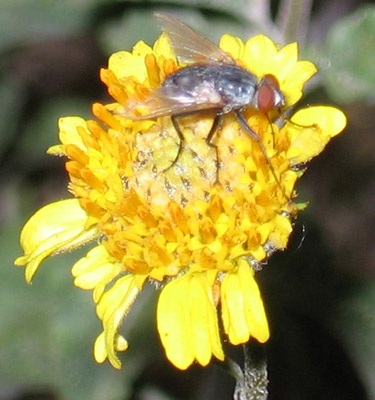
Much better than I was
expecting. After seeing how this photo turned out on the camera's display, I decided I would try to get some photos of one of
these flying moth-like creatures that were flittering everywhere as the
sky darkened. This was extremely difficult because they were so flighty.
I managed to track the moth below in complete darkness
(don't ask me how—I'm not sure) to a location where it stayed still for me
enough to take about 20 pictures, three of which turned out well. If a
reader knows what this insect is called, I'd love to
know:

35 miles
east of Silver City, New Mexico:
The [following as yet, unidentified
fanua] were taken on a private ranch I had permission to visit. I came to this
ranch to see a wind harp I had been very curious about for some time.
There's a long story behind this that involves my study and writing of
poetry. There is a picture of the structure here: http://nfo.edu/harp.htm. [Ed. a wonderful looking and sounding
wind harp.]
Unknown spider: The spider below was fascinating to me. There was another one just like it nearby, but smaller. This spider was resting on a rock about a foot from a small pond full of mosquito larva. Thinking back, I should have taken some pictures of the life that was in the pond, everything from snails to larva and even these little crab-like creatures that make "shells" out of sand and debris. I didn't think pictures taken from the surface down into the water would turn out well, but in retrospect I think it would have been worthwhile to try out a couple of shots to see how they turned out.
It almost seems to be looking at the camera doesn't it? [This is a wolf spider (family Lycosidae)—can't be sure of the genus.]

Unknown wasp: The wasp below was probably as long as my pinky finger, and probably as wide in the abdomen. Pretty impressive sight to me. As I tried to get myself and the camera at angles for what seemed like good pictures, this large wasp would buzz me and then disappear for a couple of minutes. But the wasp would come back, being very interested in this particular plant that was growing on the side of a bank next to the dirt road I was walking down. Eventually the wasp buzzed me a few good times and then disappeared long enough time that I gave up on waiting for it to return.
I have learned from that entomologist friend of mine, Derham, that it would be very unlikely for most wasps to sting another animal that just happens to be foraging or taking a curious interest in it because use of the stinger is generally reserved for paralyzing other insects for the purpose of laying eggs within. Sure glad there aren't giant wasps that do that to humans.
If I felt I had the time, I probably would have tried to follow this wasp around to see if it went after any insects for this purpose and to take pictures of the wasp in its other behaviors.
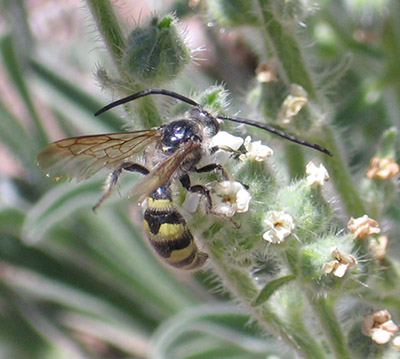
Unknown butterfly: After I got home, I was able to use an insect identification book a friend sent me to learn that this insect below is a butterfly (as opposed to a moth). I was very happy to get this picture because I had tried again and again to get pictures of butterflies the entire three and a half hours I was exploring the area. I even spend a good deal of effort slowly working my way near this butterfly or that hoping to get a picture. Invariably, they would up and flitter away. Impossible.
This one landed in partial shade, so I used the flash hoping to end up with a clear picture. It worked! You can see that the forward right wing has been badly damaged, but this didn't seem to affect its ability to fly at all. [Probably a Texan crescent butterfly (family Nymphalidae)—Phyciodes texana.]
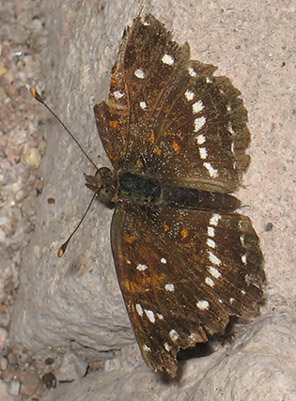
Unknown grasshopper: Grasshoppers seem to be unusually aware, and the ones I took notice of would not let me within picture-taking proximity—Except for the one below. This one flew by and landed a little ways ahead of me as I walked up a creek bed, so I decided to try walking v-e-r-y slowly toward it to see if I could get under its radar. I was successful and managed to get two decent pictures.
This guy ended up being a real good sport. It not only posed for the photos; it actually assisted. As I went to get a picture of its left side it turned such that there ended up being good lighting on it.
The shot of its right side is below left, and its left side is below right. The various patterns on its body are amazing to me, like a complex machine. It almost looks as if it could just split open with little whirring and buzzing noises to reveal a little alien pilot. You can see its rear legs are braced to send it straight into the air; it's clearly aware of my company, and wary, ready to go, but for some reason it decided to humor me:
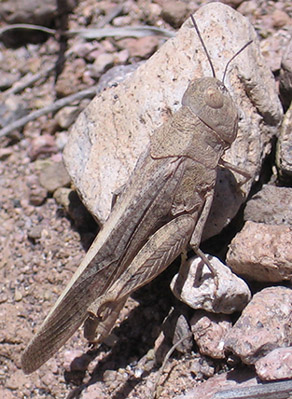
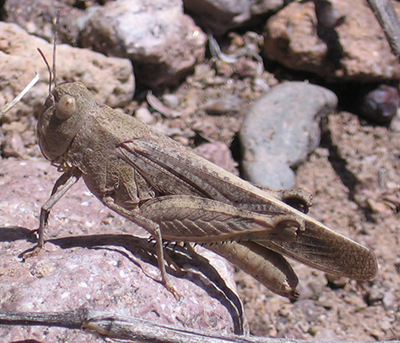
In the right hand picture above you can see the positioning of the rear tibiae (lowest unbending portion of the leg) nearly parallel with the middle tibiae. What's also interesting to me is the way the hinge on the rear legs is apparently designed to stop the legs from over extending when it leaps. Look at how thick the hinge-stop is! There must be a lot of power in that springing leap to require such a stopping mechanism. [A band-winged short-horned grasshopper (family Acrididae, subfamily Oedipodinae)—I'm not sure of the genus—possibly Circotettix?]
Unknown caterpillar: I took the picture below while walking through an abandoned vineyard that has pretty much been reclaimed by nature. This picture was tough to manage because it required poking the camera through the suspension wires that would have held up grapevines. The process was troublesome enough that I only took two photos, deciding I was happy enough with this particular photo to stop here. This caterpillar seems to have just hung itself from this plant, preparing for pupation. [Looks like either a tiger moth (family Arctiidae) or a dagger moth (family Noctuidae)—I lean toward Arctiidae.]
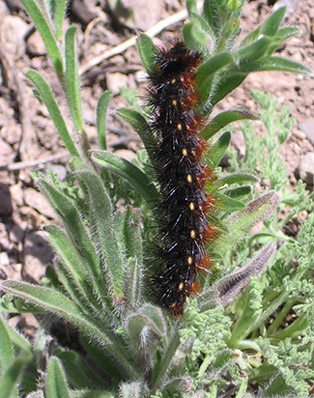
County
Road 24 in Idaho:
Unknown spider: Despite it being under a little bit of cover, I think this actually turned out
to be a fairly decent shot because it's the only shot I have that's looking at
it from this angle, making it possible to see how the legs connect to the thorax
and some of the frontal configuration. [This is a crab spider (Thomisidae) in the genus
Xysticus.]
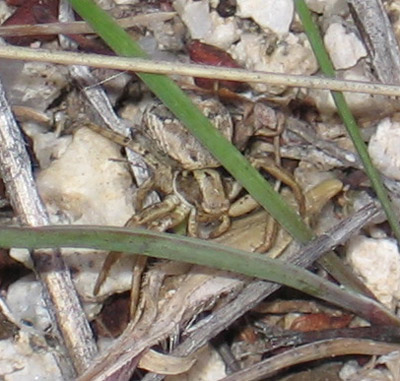
Before I took notice of this spider, I had spent about forty five minutes wandering around the area where I had just parked off the road looking for insects. I learned something valuable this time around—it is better to wait for them to make themselves known than it is to look for them. Most insects seem to be so well camouflaged that it is nearly impossible to find them by looking. I have learned that if I get to know their habitats, I can just go to a location where certain types of insects should be and just sit and wait; they'll eventually start moving around, and then I'll see them.
Unknown wasp: The wasp below was luck for me. I was walking around a field near the road wondering if I would see any interesting insects when this black wasp buzzed me. I followed it all over the field for about 20 minutes trying to get a picture, and then it lost me. As I walked up the hill toward a path that would lead back to my car, I saw it on the ground working at something—magic!
It was working at moving this large larval insect somewhere. Wasps use their stingers to paralyze victims such as this larval insect, which they lay their eggs in and bury or otherwise nest. The eggs hatch into larva that eat the insect, still alive but paralyzed, from the inside out. Gruesome, but it seems to work for the wasps.
This wasp was exceptionally active, remarkably busy. Even if it stood still for a moment, its wings would be buzzing and flipping about. I had the wasp centered in the camera when I snapped this picture, but it was just about off the lower left end of the view by the time the picture actually took. Fast![The wasp is a sphecid (family Sphecidae).]
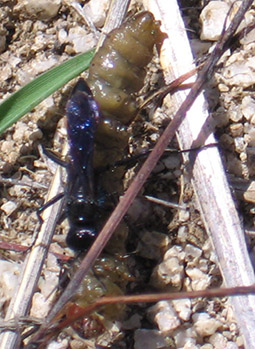
She made her way over to a tuft of grass and worked her way up into the grass as high as she could with the larval insect and actually hung it over a dried blade of grass, then went about five feet away to start working on digging a hole:
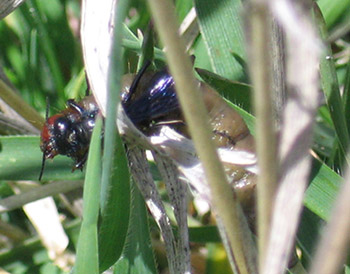
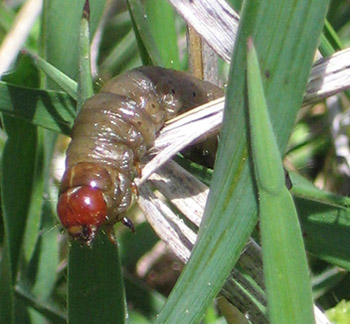
While the larval insect twitched a bit there where it was hung, the wasp was hard at work on digging a nest (below right) to put her victim in, but first she took a minute to observe the scene (below left):
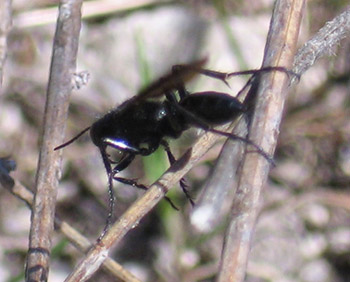
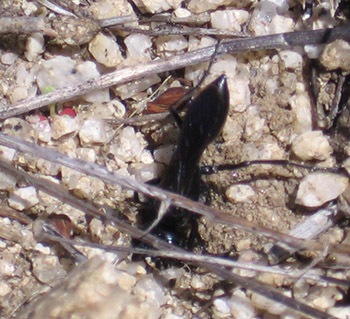
Comments to the author, Erin Thomas, are welcomed.
Microscopy UK Front Page
Micscape
Magazine
Article
Library
Please report any Web problems or offer general comments to the Micscape Editor.
Micscape is the on-line monthly magazine of the Microscopy UK web site at Microscopy-UK.